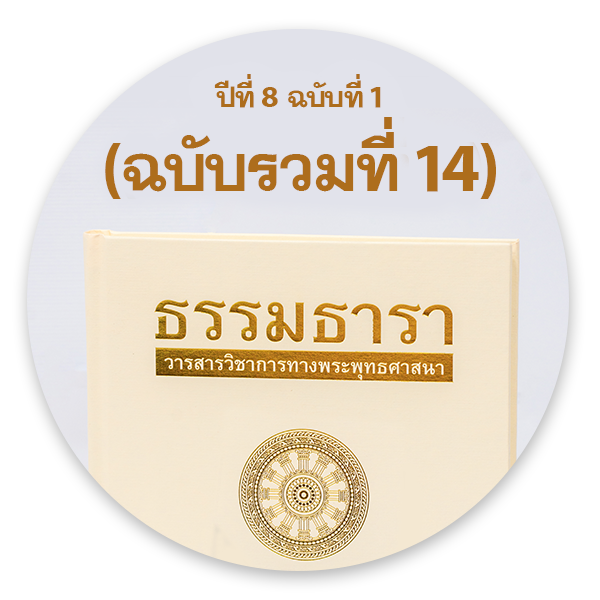Theft, the Second Defeat of Monastic Rule: An Interpretation
Main Article Content
Abstract
The article aims to propose that in the interpretation of theft, the second Defeat of the monastic rules, theft among monks must be considered from the standpoint of criminal wrongdoing according to present laws as opposed to strict rules from ancient tradition. According to Pāli tradition, the second Defeat rule measures theft by the cost of the stolen or damaged property. At the time, stealing anything worth more than 5 Māsaka, the currency in the Buddha’s time, was considered theft. The tradition has it that the Buddha legislated the rule based on the theft law of Magadha country, where the first theft occurred, and this was subsequently applied to thefts in other places. His intention to legislate the rule was to expel the wrongdoer from the monkhood so that he was punished by the state law and that the monkhood would not protect him from punishment. In my view, the Defeat rule should not be based on an ancient value of currency, because the value associated with theft changes over time, resulting in inequitable justice. To obey the spirit of the monastic rule, it is important to consider that monastic rule should be based on present law and whether the theft or the wrongful interference with goods is a crime or not. According to the Thai criminal code, a theft or a wrongful interference with goods of any cost, is regarded as a public offense in the case that the victim, or a person other than them, alleges to authorities that the wrongdoer has committed an offense according to the provisions of the code. In this way the Defeat rule, as a monastic rule in Thai society, should be reconsidered based on the modern Thai theft laws.
Article Details

This work is licensed under a Creative Commons Attribution-NonCommercial-ShareAlike 4.0 International License.
ลิขสิทธิ์ สำนักการศึกษา วัดพระธรรมกาย
References
• ภาษาไทย
---1. คัมภีร์
กรมศาสนา. พระไตรปิฎกภาษาไทย ฉบับหลวง. กรุงเทพมหานคร: กระทรวงศึกษาธิการ, 2525.
มหามกุฏราชวิทยาลัย. พระไตรปิฎกภาษาบาลี ฉบับสยามรัฐ. กรุงเทพมหานคร: โรงพิมพ์มหามกุฏราชวิทยาลัย, 2538.
---2. หนังสือ
กรมพระยาวชิรญาณวโรรส. วินัยมุข เล่ม 1. นครปฐม: โรงพิมพ์มหามกุฏราชวิทยาลัย, 2557.
คณะกรรมการแผนกตำรา. ปฐมสมันตปาสาทิกาแปล เล่ม 2. นครปฐม: โรงพิมพ์มหามกุฏราชวิทยาลัย, 2561.
คณะกรรมการแผนกตำรา. มังคลัตถทีปนีแปล เล่ม 2. นครปฐม: โรงพิมพ์มหามกุฏราชวิทยาลัย, 2560.
คณะกรรมการแผนกตำรา. อุปกรณ์วินัยมุขเล่ม 1. นครปฐม: โรงพิมพ์มหามกุฏราชวิทยาลัย, 2559.
คณะทำงานวัดเขาสนามชัย. สารพันปัญหาพระวินัย เล่ม 1. ม.ป.ท., 2558. https://drive.google.com/file/d/0B9k1g1uC3RG_alBGTjRlSTdHaEU/view.
ทวีเกียรติ มีนะกนิษฐ์. สังคมกับกฎหมาย. กรุงเทพมหานคร: วิญญูชน, 2563.
ปลื้ม โชติษฐยางกูร. คำบรรยายกฎหมายคณะสงฆ์. กรุงเทพมหานคร: มหาวิทยาลัยจุฬาลงกรณราชวิทยาลัย, 2553.
พระเทพวิสุทธิญาณ (อุบล). ข้อที่ควรจำในวินัยมุขเล่ม 1. นครปฐม: โรงพิมพ์มหามกุฏราชวิทยาลัย, 2555.
พระพรหมคุณาภรณ์ (ประยุทธ์). นิติศาสตร์แนวพุทธ. กรุงเทพมหานคร: วิญญูชน, 2555.
---3. พจนานุกรม
พระพรหมคุณาภรณ์ (ประยุทธ์). พจนานุกรมพุทธศาสน์ ฉบับประมวลศัพท์, พิมพ์ครั้งที่ 23. กรุงเทพมหานคร: มูลนิธิธรรมทานกุศลจิต, 2558.
---4. บทความ
บรรณาธิการ. “เบญจศีลกับปาราชิก.” วารสารพุทธศาสน์ศึกษาจุฬาลงกรณ์มหาวิทยาลัย, ปีที่ 22, ฉบับที่ 1, (มกราคม-เมษายน 2558): 5-12.
วิจิตร เรือนอินทร์. “การบังคับให้พระภิกษุต้องสละสมณเพศเมื่อถูกกล่าวหาคดีอาญา.” วารสารบัณฑิตศึกษาปริทรรศน์ วิทยาลัยสงฆ์นครสวรรค์, ปีที่ 7, ฉบับที่ 1, (มกราคม-เมษายน 2562): 293-306.
อำนาจ ยอดทอง. “อทินนาทานในปาราชิก: ปัญหาและทางออกในสังคมไทย.” วารสารพุทธศาสน์ศึกษา จุฬาลงกรณ์มหาวิทยาลัย, ปีที่ 22, ฉบับที่ 1, (มกราคม-เมษายน 2558): 37-59.
---5. ข้อมูลจากเว็บไซต์
มูลนิธิศึกษาและเผยแพร่พระพุทธศาสนา กระดานสนทนา. “อยากสอบถามครับ 5 มาสกนี่มันเท่าไรกันเเน่ครับ.” 2 พฤษภาคม 2557.
https://www.dhammahome.com/webboard/topic/24794.
รุจิระ บุนนาค. “คดีอาญากับการสละสมณเพศ.” สำนักกฎหมาย มารุต บุนนาค อินเตอร์เนชั่นแนล ลอว์ ออฟฟิศ, 22 มิถุนายน 2561. http://www.marutbunnag.com/article/548/.
พระวิทยา กิจฺจวิชฺโช. “5 มาสก เป็นเงินเท่าไร.” วัดป่าดอยแสงธรรมญาณสัมปันโน. https://www.doisaengdham.org/สายธารธรรม-โดยเจ้าอาวาส/5-มาสก-เป็นเงินเท่าไร.html.
Pantip. “ปัญหา 5 มาสก เป็นเท่าไหร่ตามพุทธวจนะ.” 28 มีนาคม 2558. https://pantip.com/topic/33436325.
---6. สื่อออนไลน์
พระมหาภาคภูมิ สีลานนฺโท. “5 มาสกในอทินนาทานปาราชิกถ้าคิดเป็นเงินไทยในปัจจุบันจะเท่ากับกี่บาท.” เผยแพร่เมื่อ 6 กุมภาพันธ์ 2562, วิดีโอยูทูป.
https://www.youtube.com/watch?v=MxtqTipNi9g.
---7. รัฐธรรมนูญ พระราชบัญญัติ กฎหมาย ประกาศ
ประมวลกฎหมายอาญา.” 13 พฤศจิกายน 2499. http://www.krisdika.go.th/librarian/get?sysid=443287&ext=pdf.
ประมวลกฎหมายวิธีพิจารณาความอาญา.” 5 มิถุนายน 2478. https://www.roadsafetythai.org/content/doc_20181208163504.pdf.
พระราชบัญญัติคณะสงฆ์ พ.ศ. 2505. 25 ธันวาคม 2505. https://ssc.onab.go.th/th/file/get/file/202105080effa87d1b892bfc36a4bf48b4ddf3d2155505.pdf.
• ภาษาต่างประเทศ
---1. บทความภาษาอังกฤษ
Hinüber, Oskar Von. “Buddhist Law According to the Theravada-Vinaya A Survey of Theory and Practice.” Journal for International association of Buddhist Studies, 18 (1), (1995): 7-45.


